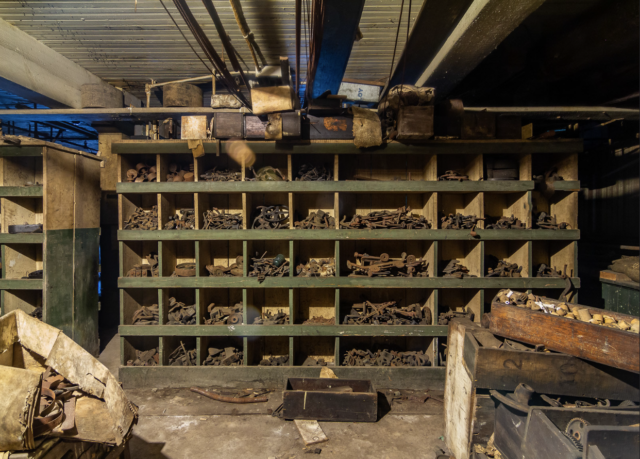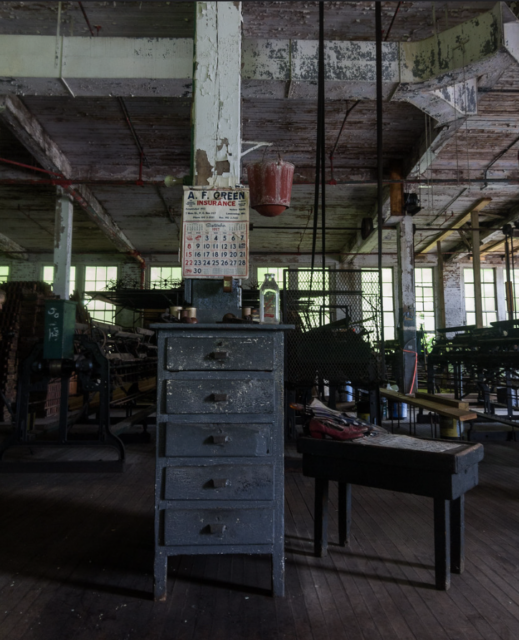Located in the small town of Lonaconing, Maryland, the Lonaconing Silk Mill offers a fascinating glimpse into America’s industrial past. The mill, which ceased operations in the mid-20th century, remains remarkably well-preserved, providing a unique window into the working conditions and daily lives of its former employees. The mill’s preservation is so thorough that it almost feels as though the workers have just stepped out for a break, leaving behind a rich tapestry of history.
The Lonaconing Silk Mill radiates eerie beauty and a strong sense of history permeates the site. The mill’s machinery, tools, and even some personal items left behind by workers are still in place, creating a time capsule effect. As such, the mill’s atmosphere is imbued with a sense of nostalgia and reverence, making it a compelling destination for anyone interested in America’s industrial heritage.
The history of the Lonaconing Silk Mill

The Lonaconing Silk Mill holds a significant place in the history of American industry. Established in 1907, it was part of a broader movement to bring silk production to the United States, reducing dependence on imported goods. The mill provided employment to many local residents, particularly women, who made up a large portion of the workforce. This employment opportunity was crucial in an era when industrial jobs were often scarce in rural areas. The mill not only offered financial stability but also fostered a sense of community among its workers.

The mill’s operation during both World Wars further underscores its historical importance. During these tumultuous times, the Lonaconing Silk Mill played a vital role in producing silk for parachutes and other military applications. This contribution to the war effort highlights the mill’s national significance and the critical role it played in supporting the country’s needs during periods of conflict. The mill’s ability to adapt and contribute to the war effort is a testament to its resilience and the ingenuity of its workforce.
Architectural features of the mill

Architecturally, the Lonaconing Silk Mill is a fascinating example of early 20th-century industrial design. The building’s brick exterior and large windows are characteristic of the period, which were designed to maximize natural light and ventilation for the workers inside. This design not only improved working conditions but also reflected the era’s emphasis on creating more humane industrial environments. The mill’s architecture is a blend of functionality and aesthetic appeal, making it a noteworthy example of industrial design from that period.

Inside the mill, the layout and machinery are equally impressive. The open floor plan allowed for efficient workflow and communication among workers. The various machines, many of which are still in place, illustrate the technological advancements of the time. From spinning wheels to looms, each piece of equipment tells a story of innovation and industrial progress. The preservation of these features makes the Lonaconing Silk Mill a valuable resource for understanding the evolution of industrial architecture and technology. The mill’s interior is a treasure trove of historical artifacts that provide a tangible connection to the past.
The mill’s decline and abandonment

Despite its early success and historical significance, the Lonaconing Silk Mill eventually faced decline. The post-World War II era brought significant changes to the American economy and industrial landscape. Advances in synthetic fibers and changes in global trade patterns reduced the demand for silk, leading to a gradual decrease in the mill’s production and profitability. By the mid-20th century, the mill could no longer compete with larger, more modern facilities, and it ultimately ceased operations in 1957. The closure marked the end of an important chapter in the town’s history.

The abandonment of the Lonaconing Silk Mill marked the end of an era for the local community. The closure not only meant the loss of jobs but also the loss of a significant cultural and social hub. Over the years, the mill has remained largely untouched, slowly succumbing to the effects of time and nature. However, this abandonment has also contributed to its unique preservation. The mill’s current state of preservation offers a rare and valuable glimpse into a bygone era.
The legacy of the Lonaconing Silk Mill

The Lonaconing Silk Mill’s legacy is multifaceted, encompassing its historical, architectural, and social significance. As one of the last remaining silk mills in the United States, it offers invaluable insights into the early 20th-century industrial era. The mill’s well-preserved state provides a rare opportunity to study the working conditions, technological advancements, and architectural design of the time.

Today, the Lonaconing Silk Mill stands as a symbol of resilience and a reminder of the ever-changing nature of industry and economy. Efforts to preserve and potentially restore the mill continue, driven by a desire to honor its historical importance and educate future generations. The Lonaconing Silk Mill remains a vital link to the past, offering a tangible connection to the lives and labors of those who once worked within its walls. The ongoing preservation efforts ensure that the mill’s legacy will continue to inspire and educate for years to come.
More from us: Huber Breaker: A Landmark of America’s Coal Mining Past That’s Since Been Demolished
Thank you to State of Abandoned for giving us permission to use their photos.
